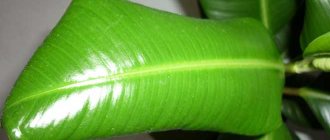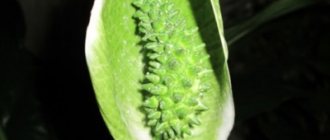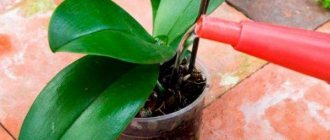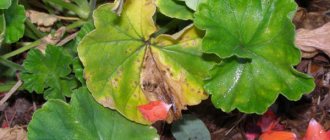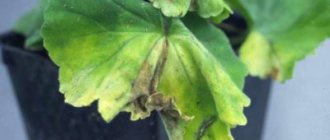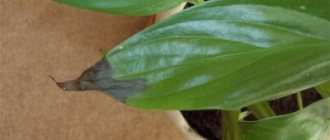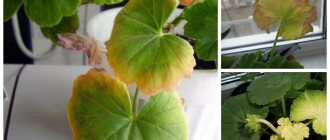Reasons for blackening of the foliage of the “female happiness” flower
Why do the leaves dry out and then darken around the edges?
The following factors lead to blackening of leaf edges:
- Insufficient air humidity . Spathiphyllum is a tropical crop, so it loves humid air (from 55-60%). In addition, a real test for a plant is not only dry, but also cold air. This leads to burns and death of the root system. And the first sign of rotting of the rhizome is dry and dark ends of the foliage.
- Sunburn . For spathiphyllum, partial shade is considered optimal light conditions. If a grower places a plant in the sun, its leaves immediately become covered with burns.
- Drafts or sudden temperature changes . Leaf plates react sharply to changes in air temperature, especially to its decrease. The leaves immediately turn yellow, dry out, and then turn black. The same effect occurs due to drafts.
If only the tips change color
The tips of spathiphyllum leaves first dry out, turn yellow or brown, and then darken for the following reasons:
- Lack or excess of nutrients . The soil becomes poorer over time, so the crop requires regular fertilizing. But you should not apply too much fertilizer. The most important thing in this matter is regularity and dosage. The optimal time for feeding is spring, the beginning of the flower growing season.
- Stagnation of moisture in the soil . This happens due to excessive moisture of the substrate. It is impossible to flood the plant; it is important to ensure that the soil is moistened, but that swampiness does not form. Also, check whether the pot has drainage holes and whether there is a drainage layer at the bottom of the pot. You also need to pay attention to the permeability of the soil. Perhaps the substrate is clogged, so the flower needs to be replanted.
What causes greenery to completely darken, what diseases can it be affected by?
The leaf blades turn completely black if all of the above negative factors are not eliminated. Also, the leaves turn completely black when infected with fungal infections.
In this case, the foliage becomes covered with black spots along the entire perimeter. Over time, this pigmentation turns into one large spot.
Additional signs of the presence of fungal diseases are the loose structure of the leaves of the “female happiness” flower; it becomes moist.
Below are photos of the affected leaves:
Reference! Often, in addition to black, brown spots also appear on the leaves. This indicates that the fungus has affected the root system.
The development of fungus is caused by low air temperatures and stagnation of water in the soil.
Spathiphyllum: leaves turn black around the edges, what to do
If the leaves of your spathiphyllum begin to turn black, you need to carefully examine the plant, since such a process can be associated not only with improper care, but also with diseases.
First of all, you need to decide which side of the sheet plate has begun to turn black. Since this particular symptom is considered the key one, let’s consider the main signs and causes of blackening in more detail.
The leaves turn black at the tips
If your spathiphyllum leaves begin to turn black and dry out at the tips, your plant is most likely suffering from improper care. First of all, you need to check the humidity of the substrate: perhaps your flower simply does not have enough moisture. But it should be borne in mind that excessive watering can also cause this process. If the leaves turn black en masse due to excess moisture, you will have to transplant the flower into a new pot.
In addition, blackening of the tips of the leaves may be due to an incorrectly selected substrate, drafts or an excess of fertilizers. In this case, you need to either replace the soil in the pot with a suitable one, or move the spathiphyllum to a new place, away from cold air currents, and stop feeding for a while.
Leaves turn black in the middle
If negative environmental factors provoke blackening of the leaves along the edges, then the formation of dark spots in the middle of the leaf indicates a completely different process - a disease (Figure 3).
Figure 3. Symptoms of fungal infection
As a rule, blackening of leaves is associated with a fungal infection of the plant. Despite the fact that spathiphyllum loves warmth and moisture, when these indicators increase, fungal spores begin to spread through the air. They cause root and leaf rot, which is accompanied by the formation of dark spots. If this happens to your flower, immediately remove the affected parts and spray the plant with a fungicide. It is also necessary to inspect the substrate: if it is too wet, the crop must be transplanted into a pot with fresh soil.
How to care for a plant at home to save it?
If a florist notices the blackening of the leaves of the “female happiness” flower and determines the reasons, then to effectively treat the blackening plant, he needs to perform the following steps :
- Treat the crop with a fungicide. Instructions for dilution and use are on each package.
- Raise the air temperature to +26 degrees.
- Remove the plant from the pot and inspect the roots for fungal damage. If there are rotten parts, cut them off and treat the cut areas with crushed coal.
- Reduce the frequency and abundance of watering by half. The next moistening of the soil should occur after a third of the soil layer has dried.
- Use complex fertilizers. In spring, fertilizing is applied every week. In summer, you can apply once every 10 days. During the rest period, it is allowed to feed the crop for its complete restoration - once a month will be enough.
- Trim off all affected areas of spathiphyllum.
- Spray the plant with water (you can add a growth stimulator to it).
Causes of yellowing of spathiphyllum leaves
Yellow leaves of spathiphyllum appear not only due to some disease, but in this way the plant can devote all its energy to preparing for flowering or recovering after it. The same changes occur with the old flower, which no longer has enough strength due to its age.
It is necessary to figure out which leaves of the flower turn yellow - old ones at its base or young, just emerging shoots. There is nothing to worry about when old leaves turn yellow. This is how the flower gets rid of non-viable parts in order to direct all its energies to rejuvenation and the appearance of new leaves. When yellowness appears on young shoots, you most likely need to pay attention to the lighting. Leaves can change color when exposed to direct sunlight. Sunburn is very dangerous for this houseplant. It is worth moving the spathiphyllum to another room or rearranging it to another place.
If negative changes appear in the appearance of your pet, you should not panic. If you find out in time the reason for the withering and drying of a plant or its parts, then the flower can be saved and given a second life so that it continues to delight with its exotic blooms.
What to do if the plant has blackened flowers?
When flowers turn black, the gardener should have the following algorithm of actions::
- Check the soil mixture for flooding. If there is a lot of water in the soil, remove it from the pot and let it dry completely.
- Humidify the air. To do this, place a container of water or moistened expanded clay next to the crop, and also spray it daily with water at room temperature.
- Remove the flower from drafts and direct sunlight.
Blackening of leaves and flowers in spathiphyllum is a common problem. The plant is tropical, so the climatic conditions of our premises are not always suitable for it. The gardener’s task is to provide the crop with conditions optimal for normal growth and flowering.
Blackening of leaves and flowers indicates errors in care, as well as an attack of fungal infections. You need to start reviving the plant immediately after the first signs appear. Otherwise, it may not be possible to save culture.
Plant prevention
If you have managed to identify and eliminate the cause of the blackening of the leaves, you should take certain measures to prevent similar problems in the future.
Preventive measures for spathiphyllum are as follows:
- Watering should be plentiful, but not excessive. You can determine that a plant needs moisture by the degree of moisture in the substrate. If it has dried to a depth of 2-3 cm, you need to water the flower.
- To increase air humidity, especially in the cold season, you should regularly spray the plant or wash its leaves with a damp sponge. This event will not only increase the air humidity in the room, but will also serve as excellent protection against pests.
- Fertilizing must be done carefully, strictly observing the dosage. In the case of spathiphyllum, it is better to under-fertilize a little than to cause an excess of minerals in the soil.
In addition, you need to carefully select a place to place spathiphyllum in the house. It is advisable to place it on eastern or western windowsills, where the light is bright enough, but diffused, and the plant cannot suffer from sunburn.
Excessive feeding
Indoor flowers need fertilizer, just like their outdoor counterparts. But there are some differences here. For a plant in a pot, you must not exceed the dose indicated in the instructions; this can lead to overfeeding, with all the ensuing consequences, including blackening and dying of leaves. This is due to the fact that excess minerals in the soil can lead to rotting of the root system. And as a result - blackening of the leaf plates.
The correct solution in such a situation would be to replace the soil in the pot with fresh one. When replanting, you should examine the condition of the root system by carefully removing rotten and dead roots. After this, fertilizing can be done as usual.
When buying a flower in a store, there is no need to replant it in the first month and a half. The nutritional mixture in the pot is designed specifically for this time due to its beneficial properties.
Prevention of wet and dry blackening
If, after treating the flower, symptoms reappear, it is recommended to think about taking preventive measures that will help strengthen the spathiphyllum. It is necessary to limit external factors. To do this, it is not recommended to allow cold outside air to enter the room and not to ventilate the flower. In summer you can take spathiphyllum outside.
Anthurium flower - why leaves and flowers turn black and dry
In the apartment it is worth creating the most comfortable conditions for the presence of an exotic plant in it. The temperature should be +23 degrees Celsius. It is also worth maintaining air humidity around 50-60%. It is not recommended to forget about spraying the leaves of the flower, but this procedure must be carried out as needed.
The flower pot should be placed in a sunny place, but the rays must be dispersed using special fabrics and awnings. Regular watering involves checking the moisture level in the soil.
Feeding should be done depending on the time of year, as well as necessity. If they were applied too often or in high concentrations, it is worth refraining from fertilizers for a while. But if the flower withers due to a lack of nutrients in the soil, it is necessary to add special complexes for aroid plants.
Additional Information! It is worth choosing certain neighbors for your indoor flower. It is not recommended to keep it next to callas, dieffenbachias and anthuriums, since from them the spathiphyllum can become infected with gommosis.
Quite often there is a situation when the leaves of an indoor spathiphyllum flower turn black around the edges; not every gardener knows what to do in this case. Coping with the problem is quite simple, you just need to understand in time the cause of this phenomenon, and also take measures to eliminate it. You should learn how to properly care for the plant so that the spathiphyllum will delight you with regular flowering and the colorfulness of its leaves.
Useful care tips
Some useful recommendations regarding growing spathiphyllum:
- When choosing a place for a plant, avoid drafts.
- To increase the flower's endurance, move it to the balcony or garden during warm periods.
- Do not change the location of the plant too often, especially during the flowering period.
- When choosing spathiphyllum in the store, give preference to hybrid varieties - they bloom all year round.
- If you have an aquarium with fish at home, you can periodically use the waste liquid to water the plant, after filtering it through cheesecloth.
- If a whitish coating appears on the surface of the soil, add 3 drops of lemon juice or oxalic acid to the water for irrigation.
Darkening of spathiphyllum leaves indicates shortcomings in care related to the plant’s nutrition, as well as water quality and humidity conditions. Almost all mistakes can be easily corrected, but it’s still better to try to avoid them.
Flower moisture requirements
Spathiphyllum loves water very much, so it must be watered regularly, not allowing the soil to dry out completely. Then the leaves of the plant become sluggish and droop, and if such situations are repeated often, they begin to turn yellow and become covered with spots.
To help the flower, you need to arrange watering and continue to moisten the soil as soon as its top layer dries out. As an emergency measure, you can spray the bush generously.
However, you can’t flood the plant either. In constantly moist soil, putrefactive processes begin, which negatively affects the leaves and the general condition of the spathiphyllum. To avoid overfilling, the pot must have drainage and drain holes.
The flooded flower must be left alone for a while so that the soil dries out, pouring out all the water from the pan.
Possible consequences of blackening
Blackening of leaves is always unsightly and dangerous, regardless of the type of plant. If the spathiphyllum begins to turn black, then the problem is serious and needs to be solved quickly. Otherwise, the blackening will begin to spread to neighboring leaves, they will dry or rot, fall off, and over time the crop will die.
If the cause of the black leaves is a fungus, then it can move from the spathiphyllum to neighboring flowers and affect them as well. Often such fungi cause a real epidemic among the flowers in the house, and the longer you delay treatment, the less chance of successful recovery of your favorite indoor plants!
Care errors
If trouble happened after the temperature in the room dropped, it is reasonable to assume that the pot was simply flooded, and now it is necessary to reduce the frequency of watering and try to remove excess moisture from the soil. To do this, you can use sphagnum moss, which absorbs moisture from the soil surface. When the damage is not limited to the dried tips of the leaves of the spathiphyllum, but also affects the roots, then, in addition to changing the watering schedule and pruning blackened foliage, you will have to inspect the underground part of the bush, as well as the bases of the petioles.
The roots are carefully washed, the blackened ones are cut off and healthy areas are treated with charcoal powder. Then the plant can be planted in the soil, remembering that it must be loose, because blackening of the leaves is more often observed in spathiphyllums growing in heavy soil that becomes very dense after watering. Do not forget about the thick layer of drainage, which ensures the outflow of excess moisture from the roots.
It is recommended to treat the damaged plant and the soil underneath it with a fungicide to prevent the risk of the development of parasitic fungi.
When understanding the reasons why the tips of spathiphyllum leaves turn black and what to do with a plant that has lost its attractiveness, you need to remember the temperature of the bush. For better health, spathiphyllum should be kept in a draft-free room, where the temperature in winter will not fall below 7.5–10 °C, depending on the plant variety. And the optimal daytime temperature in summer is 20–29 °C. At night, a decrease of 2–4 degrees is acceptable.
If spathiphyllum finds itself in uncomfortable conditions, for example, on a brightly lit window, burns of the leaf plates cannot be avoided.
Such spots also have a brown or almost black tint, especially when the bush has been seriously damaged by sunlight. The easiest way to solve this problem is. The pot with the plant is moved to where the sun is more gentle, or a translucent screen is placed between the glass and the pot to shade the spathiphyllum.
Interesting things about spathiphyllum
People believe that this plant brings happiness to women and helps improve family life:
- According to ancient legend, on the wedding day, the goddess of love breathed into him a little of her own happiness so that he would bring good luck to all representatives of the fair sex. The benefits of the flower will be greater if you give it to a girl;
- The magical power of spathiphyllum appears only at the moment of flowering;
- There is also male happiness - Anthurium, the only difference is the color of the inflorescences. For the patron of the stronger sex, they are red. If both flowers are grown on the same milk tray, then harmony will reign between the lovers;
- The flower is also called the “house spirit”. Some are sure that it scares away bad people and unexpected guests from the house.
Spathiphyllum is a delicate and fragile flower, and if not properly cared for, the plant may die.

